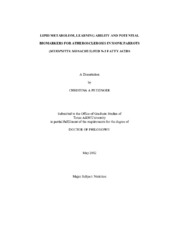| dc.description.abstract | Atherosclerosis, an inflammatory disease characterized by plaque formation in the arteries, commonly occurs in mammals, including humans, and some avian species. Polyunsaturated n-3 fatty acids have been shown to reduce known mammalian risk factors associated with the development of atherosclerosis in mammals. N-3 polyunsaturated fatty acids (PUFA) have also been linked to improving retinal, neurological, and brain development and functioning. In order to assess the effects of n-3 PUFA on potential risk factors for atherosclerosis in avian species and learning ability, a series of studies were conducted in Monk parrots: 1) alterations comparing a high linoleic acid diet with -linolenic acid (ALA) diet on lipid metabolism, fatty acid conversions, and lipoproteins, 2) the dose response of ALA and comparison with a high docosahexaenoic acid (DHA) diet on lipid metabolism, fatty acid conversions, and markers of oxidation, 3) the effect of a high DHA diet on learning ability, and 4) assessment of growing energy requirement estimations to improve adult health.
Monk parrots were able to convert ALA to DHA and also retro-convert DHA/docosapentaenoic acid (DPA) to eicosapentaenoic acid (EPA). Feeding Monk parrots a high ALA diet resulted in a shift in the peak density of the high-density lipoproteins after 70 days. Decreased superoxide dismutase and increased malondialdehyde were observed by day 63 regardless of dietary n-3 PUFA levels or source. Higher plasma phospholipid DHA levels at day 28 were obtained when n-3 PUFA were provided in the diet as DHA rather than ALA (at equivalent amounts). Total plasma cholesterol, free cholesterol, esterified cholesterol, and triacylglycerol concentrations were not altered by increasing dietary n-3 PUFA. An effect of DHA on learning ability could not be concluded due to decreased power from adjusting for an age effect. Additionally, the growing energy needs for Monk parrots through day 23 after hatching were estimated and, unlike previous general equations, accounted for changes in growth energy requirements. These closer energy estimations that accounted for growth energy variations will hopefully prevent negative fluctuations in growth rate which were observed in the study and prevent obese fledgling and young adult birds.
In conclusion, Monk parrots are able to benefit from dietary n-3 PUFA provided as either ALA or DHA. Although, dietary DHA may provide more protection against the development of atherosclerosis due to its higher accumulation into plasma phospholipids and retro-conversion to EPA. However, caution should be used when feeding PUFA, as they increase oxidation in the body. While many risk factors for atherosclerosis have been determined in humans and other mammals, some of these do not appear to hold for Monk parrots and possibly other avian species prone to atherosclerosis. | en |


